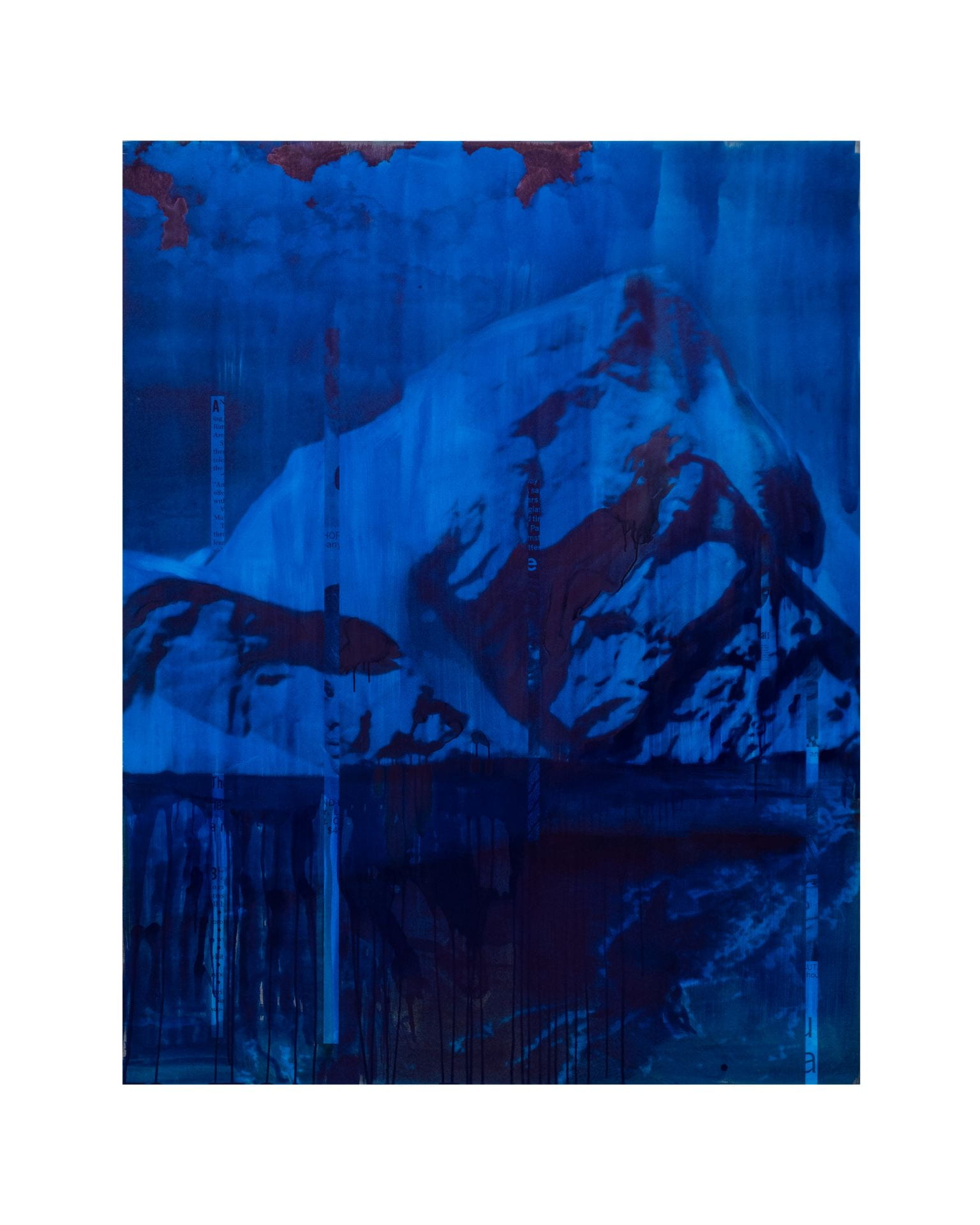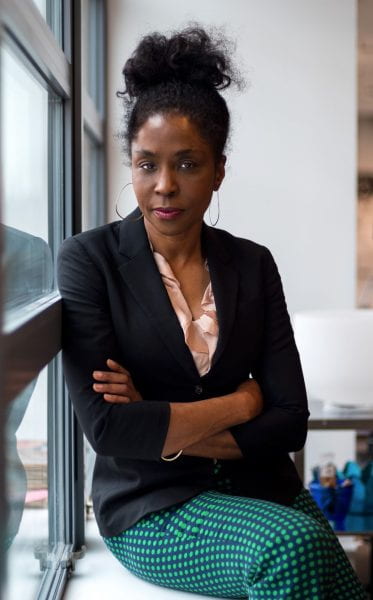
© Lorna Simpson. Courtesy the artist and Hauser & Wirth. Photo: James Wang
Lorna Simpson, Night Light (2019)
Written by Zahra Nasser, BA in Art History and Philosophy, 2022 in collaboration with Brandon Truett, PhD ‘20
Night Light (2019) is a work in Simpson’s “Ice Series” (2018–2019), and is accordingly glacial. Much like the underbelly of the arctic, the fiberglass canvas has a dark side, the product of poured ink which appears like an oil spill in the far background. Faint female visages blend into the cracks of the image’s mountainous figure, their faces slivers of screen-printed newspaper which cut through the darkest areas of the work. These vertical slivers contrast with the arbitrariness of ink drippings and a textured topography. As such, Night Light exemplifies the environments Simpson creates in her art—ones that appear cloudy and nebulous because they are a combination of various visual elements: photography, painting, and miscellaneous printed media. They all come together to explore issues of gender, race, and Black women.
Simpson’s conceptual practice interrogates media ranging from photography to collage to installation, but her more recent works may primarily be an interrogation of color itself, rather than of a particular medium. The inky blues and blacks of Night Light assert ink and brush as prominent tools of interest for an artist who began her career categorized as a photographer.
Read More
An excerpt from the 2017 poem Using Black to Paint Light: Walking Through a Matisse Exhibit Thinking about the Arctic and Matthew Henson by Robin Coste Lewis, appeared at the start of “Darkening,” the 2019 Hauser and Wirth exhibition featuring Night Light. Coste writes,
“The unanticipated shock: so much believed to be white is actually – strikingly – / blue. / Endless blueness. / White is blue. / An ocean wave freezes in place. /Blue.
Whole glaciers, large as Ohio, floating masses of static water. / All of them pale
frosted azuls. / It makes me wonder – yet again – was there ever such a thing
as whiteness? / I am beginning to grow suspicious. / An open window…
Simpson, breaking new ground in her career by venturing into painting, asks us to consider color when viewing Night Light, just as Coste does; are we seeing truly blue ink, even when it seems to go black and white in some areas of the canvas? Like Coste, Simpson’s work is inspired by the story of Matthew Henson, the Black explorer who discovered the North Pole in 1910. An activist and poetic work; its focus on the arctic from both a physical and metaphysical standpoint inspires a close reading of familiar elements turned abstract and amorphous, challenging the ways in which we construct assumptions about issues of identity based on visual cues. Her works, even when painted, often draw upon literature and photography, the resulting juxtaposition invites the viewer to interpret one medium in terms of the other.
The focus of the image is its mountainous figure, featuring moments of light and dark and smooth and jagged, under which the darkest moment of the work resides, appearing as an ocean. While Night Light hardly features stark, black and white aesthetic that characterizes Simpson’s early photographs, an ambiguous visual language, one composed of several elements painted, photographed, and printed, persists. As the textual elements are subtle, the color palette is anything but. The enveloping blueness of the work speaks to the fact that the arctic might be more blue than it is white—that beneath all of the whiteness is an expansive, unseen history.
The disparate visual elements comprising Night Light are sutured together to create multiple images in one stretch of fiberglass. The bits of text in the canvas are difficult to decipher; however, that they derive from Jet and Ebony Magazine, two mid-century Black print publications produced by the Johnson Publishing Company, recall the historicity of the arctic. We do not have direct access to the printed words, and as such, Simpson encourages us to wade through the unknown environment.
Simpson’s use of this material in Night Light speaks to an interest in archiving narratives told by Black people about Black people, while connecting elements of Black history that have been forgotten or dismissed, like the story of Matthew Henson. Henson’s contributions to the discovery of the North Pole were largely ignored; his white counterpart, Robert Peary, is often solely credited for the fruits of the duo’s seven voyages through the Arctic. Again, while whiteness appears prominently at the surface—of this image, and of history itself—the fuller, deeper truth lies beneath what is immediately perceptible.
Artist and University of Chicago professor Theaster Gates has also taken great interest in the preservation of Ebony and Jet Magazine. In 2018, he curated the exhibition, A Johnson Publishing Story at Chicago’s Rebuild Foundation, which was a celebration and exploration of the titan of Black print media, as well as a memorialization of the stories it told, and continues to tell, about the lives of African Americans.
Artist Profile

Lorna Simpson
American, born 1960
© Lorna Simpson. Courtesy the artist and Hauser & Wirth. Photo: James Wang
Written by Zahra Nasser, BA in Art History and Philosophy, 2022 in collaboration with Brandon Truett, PhD ‘20
Initially working within documentary photography, Lorna Simpson’s practice has transformed over the course of her career. The Brooklyn-native has experimented with various media, from photography, to film, and to painting. Issues of memory, objectivity, and identity—as well as their intersections— have long been central to their constantly diversifying practice.
Simpson’s work features combinations of fragmented images and text, with Black women often appearing as the primary subjects. The anonymity of the women prompts the viewer to draw upon, and make associations from, Simpson’s accompanying words, printed within or alongside her paintings and photography. For Simpson, this process takes the following shape, in this 1997 interview for BOMB magazine she states: “When I take a picture, I have an idea in my head, and I try to make it work. Then I play with language to get what I want.” Simpson’s interest in reaching a desired endpoint regardless of media is pivotal to her practice.
Years of critical acclaim attests to the fact that Simpson has broken new ground as a Black female artist in an historically white, male dominated art world. With her ever-changing interests and experimentation, Simpson emphasizes her autonomy and rejection of the cubbyhole to which Black artists are frequently condemned. Professor Darby English, whose scholarship has probed stultifying generalizations made in and about Black art, identifies this cubbyhole in his 2022 interview with Artnews as “a way for anti-Black racism to keep the conceptual and practical ranges as narrow as possible.” He continues, “Today we produce it internally, replicating in our own image a situation where the range of subjects Black artists can speak to is shockingly narrow—far narrower than their actual engagements indicate.” Simpson defies this narrowing, taking up new subject matter—from the concept of time to the concept of ice—with each work of art she creates.
Related Links
Professor Theaster Gates: Black Image Corporation
Professor Darby English: How to See a Work of Art in Total Darkness
Smart Museum of Art, Three Seated Figures (1989) by Lorna Simpson
